Enhancing Construction with BIM in Integrated Project Management
VerifiedAdded on 2020/02/18
|17
|4220
|203
Report
AI Summary
This report provides an overview of integrated project management using Building Information Modeling (BIM) in the construction industry. It discusses the transformation from traditional methods to BIM-enabled processes, emphasizing improved efficiency, collaboration, and resource management. The report details the collaboration between BIM and knowledge management, highlighting how BIM tools aid in quantifying information, monitoring data flow, and ensuring even resource distribution. It presents a conceptual framework of BIM, explaining its role in enhancing construction activities, improving decision-making, and mitigating risks. Furthermore, the report addresses the implications of BIM, including technological advancements, process improvements, and the development of new policies and procedures. It outlines BIM knowledge management procedures, covering issue creation, knowledge sharing, and updating phases. The benefits of BIM, such as enhanced project quality, clash resolution, and improved stakeholder communication, are discussed, along with challenges like software limitations and interoperability issues. Finally, the report emphasizes the role of BIM in construction project, including 4D virtualization and automatic progress checking. Desklib offers similar solved assignments and resources for students.

Assignment on Integrated project
management
September 5
2017
management
September 5
2017
Paraphrase This Document
Need a fresh take? Get an instant paraphrase of this document with our AI Paraphraser
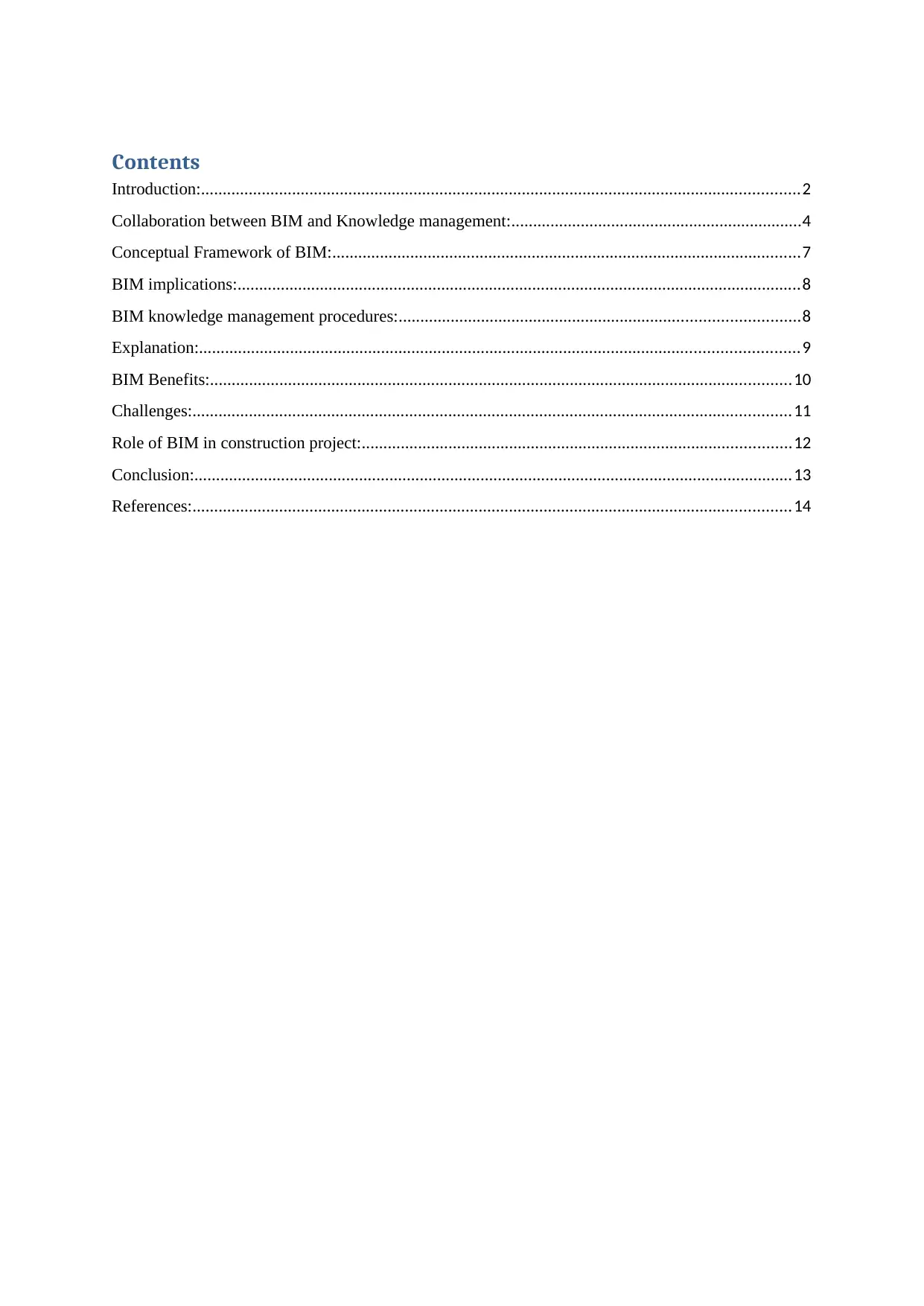
Contents
Introduction:..........................................................................................................................................2
Collaboration between BIM and Knowledge management:...................................................................4
Conceptual Framework of BIM:............................................................................................................7
BIM implications:..................................................................................................................................8
BIM knowledge management procedures:............................................................................................8
Explanation:..........................................................................................................................................9
BIM Benefits:......................................................................................................................................10
Challenges:..........................................................................................................................................11
Role of BIM in construction project:...................................................................................................12
Conclusion:..........................................................................................................................................13
References:..........................................................................................................................................14
Introduction:..........................................................................................................................................2
Collaboration between BIM and Knowledge management:...................................................................4
Conceptual Framework of BIM:............................................................................................................7
BIM implications:..................................................................................................................................8
BIM knowledge management procedures:............................................................................................8
Explanation:..........................................................................................................................................9
BIM Benefits:......................................................................................................................................10
Challenges:..........................................................................................................................................11
Role of BIM in construction project:...................................................................................................12
Conclusion:..........................................................................................................................................13
References:..........................................................................................................................................14
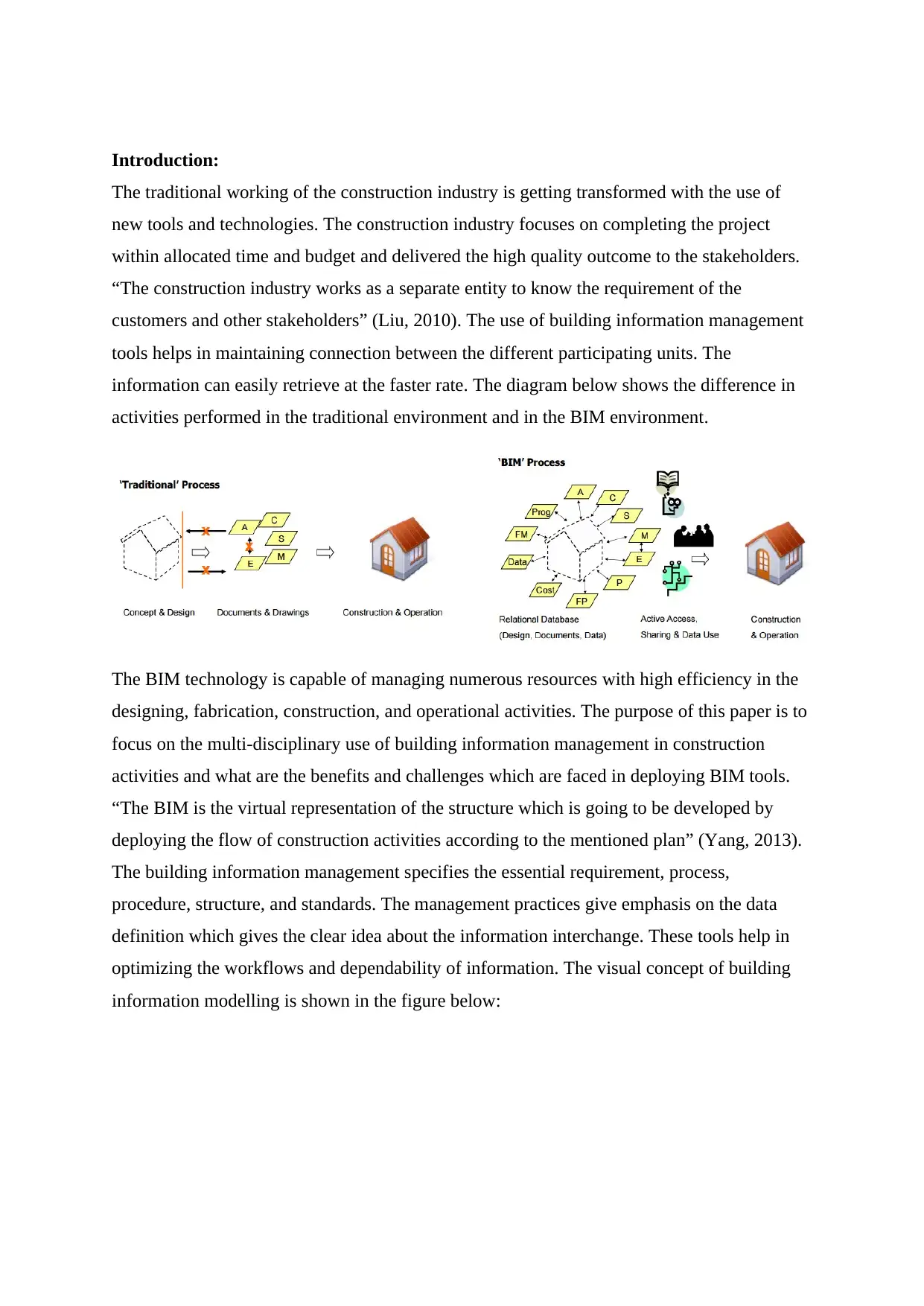
Introduction:
The traditional working of the construction industry is getting transformed with the use of
new tools and technologies. The construction industry focuses on completing the project
within allocated time and budget and delivered the high quality outcome to the stakeholders.
“The construction industry works as a separate entity to know the requirement of the
customers and other stakeholders” (Liu, 2010). The use of building information management
tools helps in maintaining connection between the different participating units. The
information can easily retrieve at the faster rate. The diagram below shows the difference in
activities performed in the traditional environment and in the BIM environment.
The BIM technology is capable of managing numerous resources with high efficiency in the
designing, fabrication, construction, and operational activities. The purpose of this paper is to
focus on the multi-disciplinary use of building information management in construction
activities and what are the benefits and challenges which are faced in deploying BIM tools.
“The BIM is the virtual representation of the structure which is going to be developed by
deploying the flow of construction activities according to the mentioned plan” (Yang, 2013).
The building information management specifies the essential requirement, process,
procedure, structure, and standards. The management practices give emphasis on the data
definition which gives the clear idea about the information interchange. These tools help in
optimizing the workflows and dependability of information. The visual concept of building
information modelling is shown in the figure below:
The traditional working of the construction industry is getting transformed with the use of
new tools and technologies. The construction industry focuses on completing the project
within allocated time and budget and delivered the high quality outcome to the stakeholders.
“The construction industry works as a separate entity to know the requirement of the
customers and other stakeholders” (Liu, 2010). The use of building information management
tools helps in maintaining connection between the different participating units. The
information can easily retrieve at the faster rate. The diagram below shows the difference in
activities performed in the traditional environment and in the BIM environment.
The BIM technology is capable of managing numerous resources with high efficiency in the
designing, fabrication, construction, and operational activities. The purpose of this paper is to
focus on the multi-disciplinary use of building information management in construction
activities and what are the benefits and challenges which are faced in deploying BIM tools.
“The BIM is the virtual representation of the structure which is going to be developed by
deploying the flow of construction activities according to the mentioned plan” (Yang, 2013).
The building information management specifies the essential requirement, process,
procedure, structure, and standards. The management practices give emphasis on the data
definition which gives the clear idea about the information interchange. These tools help in
optimizing the workflows and dependability of information. The visual concept of building
information modelling is shown in the figure below:
⊘ This is a preview!⊘
Do you want full access?
Subscribe today to unlock all pages.

Trusted by 1+ million students worldwide
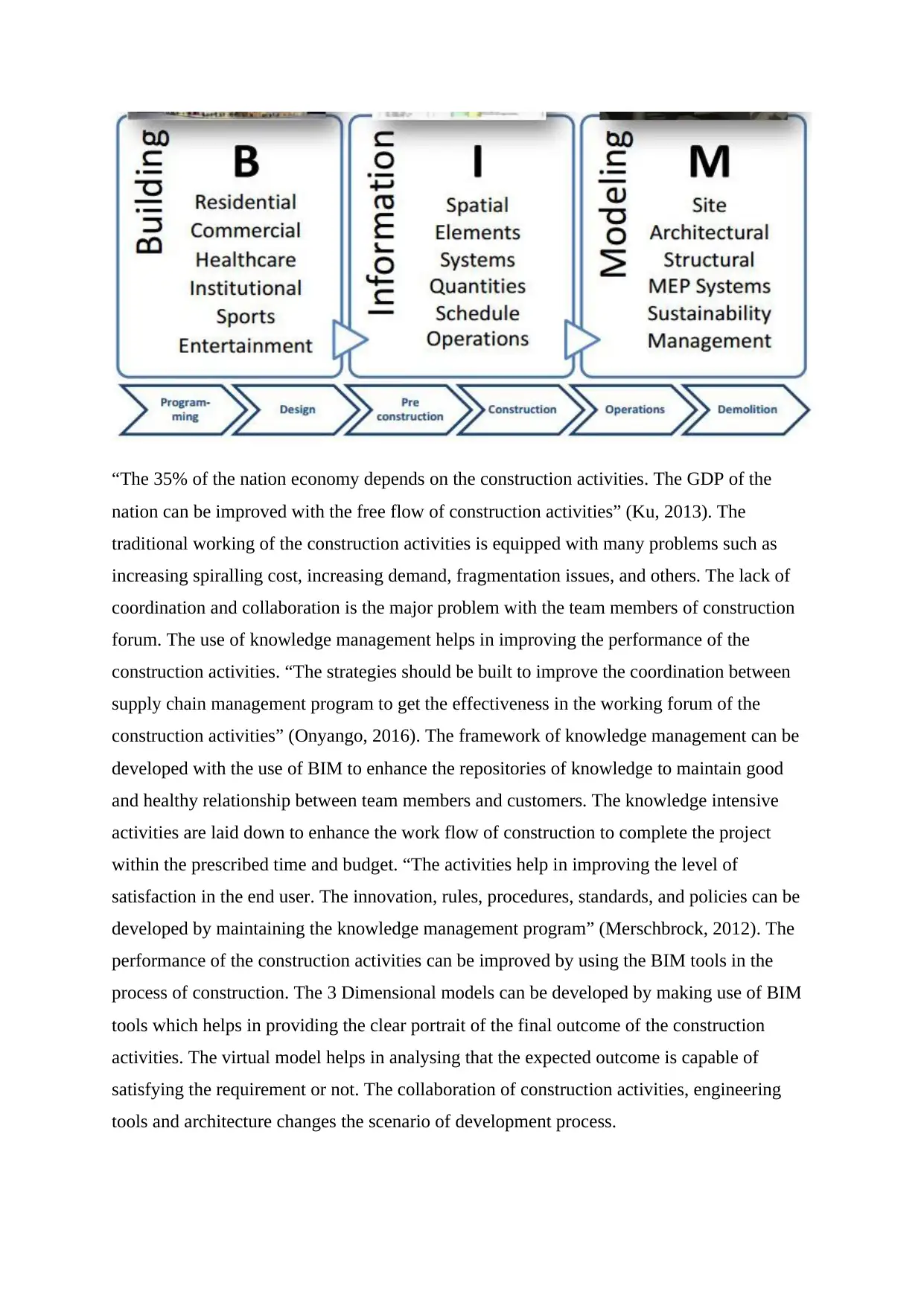
“The 35% of the nation economy depends on the construction activities. The GDP of the
nation can be improved with the free flow of construction activities” (Ku, 2013). The
traditional working of the construction activities is equipped with many problems such as
increasing spiralling cost, increasing demand, fragmentation issues, and others. The lack of
coordination and collaboration is the major problem with the team members of construction
forum. The use of knowledge management helps in improving the performance of the
construction activities. “The strategies should be built to improve the coordination between
supply chain management program to get the effectiveness in the working forum of the
construction activities” (Onyango, 2016). The framework of knowledge management can be
developed with the use of BIM to enhance the repositories of knowledge to maintain good
and healthy relationship between team members and customers. The knowledge intensive
activities are laid down to enhance the work flow of construction to complete the project
within the prescribed time and budget. “The activities help in improving the level of
satisfaction in the end user. The innovation, rules, procedures, standards, and policies can be
developed by maintaining the knowledge management program” (Merschbrock, 2012). The
performance of the construction activities can be improved by using the BIM tools in the
process of construction. The 3 Dimensional models can be developed by making use of BIM
tools which helps in providing the clear portrait of the final outcome of the construction
activities. The virtual model helps in analysing that the expected outcome is capable of
satisfying the requirement or not. The collaboration of construction activities, engineering
tools and architecture changes the scenario of development process.
nation can be improved with the free flow of construction activities” (Ku, 2013). The
traditional working of the construction activities is equipped with many problems such as
increasing spiralling cost, increasing demand, fragmentation issues, and others. The lack of
coordination and collaboration is the major problem with the team members of construction
forum. The use of knowledge management helps in improving the performance of the
construction activities. “The strategies should be built to improve the coordination between
supply chain management program to get the effectiveness in the working forum of the
construction activities” (Onyango, 2016). The framework of knowledge management can be
developed with the use of BIM to enhance the repositories of knowledge to maintain good
and healthy relationship between team members and customers. The knowledge intensive
activities are laid down to enhance the work flow of construction to complete the project
within the prescribed time and budget. “The activities help in improving the level of
satisfaction in the end user. The innovation, rules, procedures, standards, and policies can be
developed by maintaining the knowledge management program” (Merschbrock, 2012). The
performance of the construction activities can be improved by using the BIM tools in the
process of construction. The 3 Dimensional models can be developed by making use of BIM
tools which helps in providing the clear portrait of the final outcome of the construction
activities. The virtual model helps in analysing that the expected outcome is capable of
satisfying the requirement or not. The collaboration of construction activities, engineering
tools and architecture changes the scenario of development process.
Paraphrase This Document
Need a fresh take? Get an instant paraphrase of this document with our AI Paraphraser
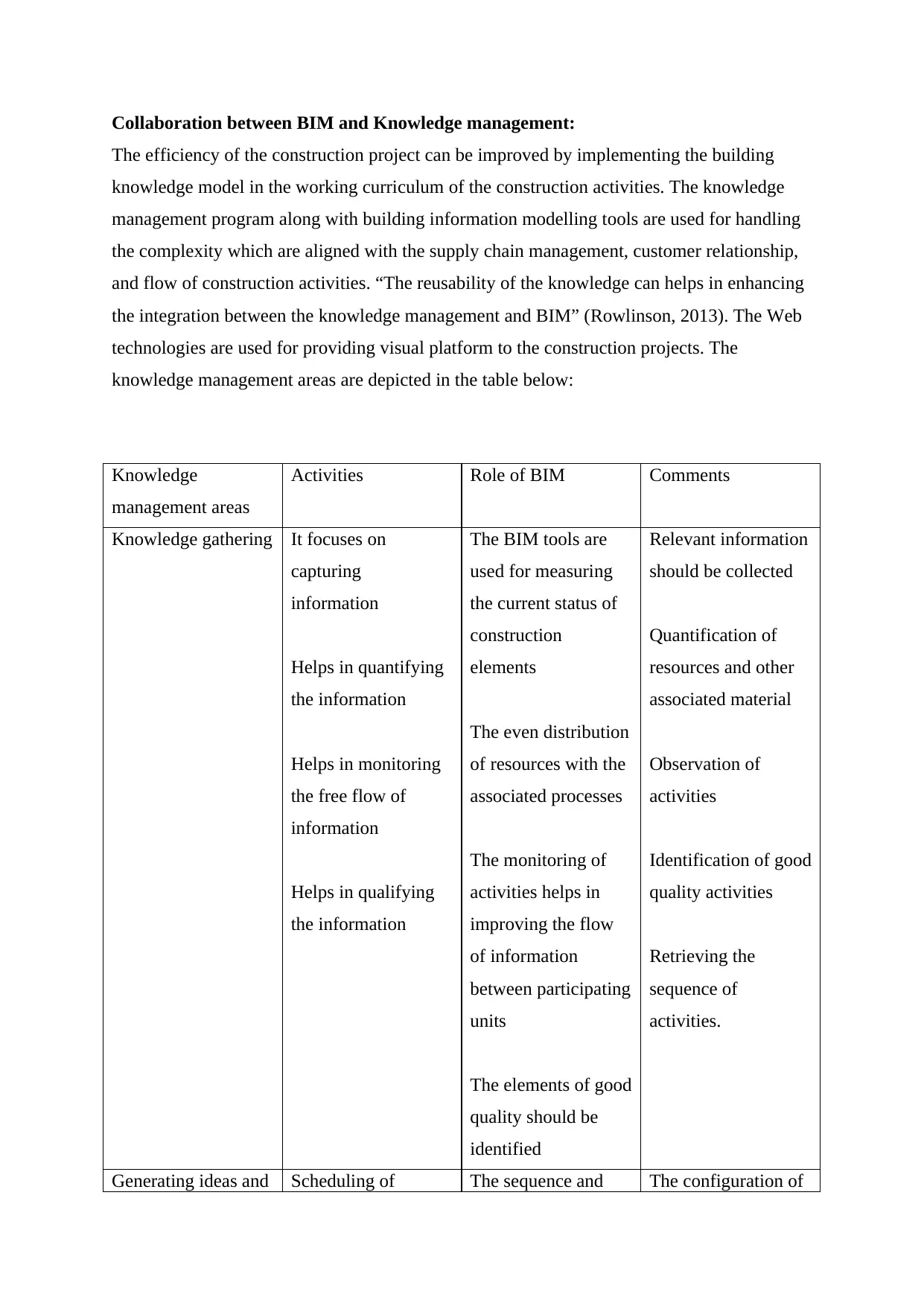
Collaboration between BIM and Knowledge management:
The efficiency of the construction project can be improved by implementing the building
knowledge model in the working curriculum of the construction activities. The knowledge
management program along with building information modelling tools are used for handling
the complexity which are aligned with the supply chain management, customer relationship,
and flow of construction activities. “The reusability of the knowledge can helps in enhancing
the integration between the knowledge management and BIM” (Rowlinson, 2013). The Web
technologies are used for providing visual platform to the construction projects. The
knowledge management areas are depicted in the table below:
Knowledge
management areas
Activities Role of BIM Comments
Knowledge gathering It focuses on
capturing
information
Helps in quantifying
the information
Helps in monitoring
the free flow of
information
Helps in qualifying
the information
The BIM tools are
used for measuring
the current status of
construction
elements
The even distribution
of resources with the
associated processes
The monitoring of
activities helps in
improving the flow
of information
between participating
units
The elements of good
quality should be
identified
Relevant information
should be collected
Quantification of
resources and other
associated material
Observation of
activities
Identification of good
quality activities
Retrieving the
sequence of
activities.
Generating ideas and Scheduling of The sequence and The configuration of
The efficiency of the construction project can be improved by implementing the building
knowledge model in the working curriculum of the construction activities. The knowledge
management program along with building information modelling tools are used for handling
the complexity which are aligned with the supply chain management, customer relationship,
and flow of construction activities. “The reusability of the knowledge can helps in enhancing
the integration between the knowledge management and BIM” (Rowlinson, 2013). The Web
technologies are used for providing visual platform to the construction projects. The
knowledge management areas are depicted in the table below:
Knowledge
management areas
Activities Role of BIM Comments
Knowledge gathering It focuses on
capturing
information
Helps in quantifying
the information
Helps in monitoring
the free flow of
information
Helps in qualifying
the information
The BIM tools are
used for measuring
the current status of
construction
elements
The even distribution
of resources with the
associated processes
The monitoring of
activities helps in
improving the flow
of information
between participating
units
The elements of good
quality should be
identified
Relevant information
should be collected
Quantification of
resources and other
associated material
Observation of
activities
Identification of good
quality activities
Retrieving the
sequence of
activities.
Generating ideas and Scheduling of The sequence and The configuration of
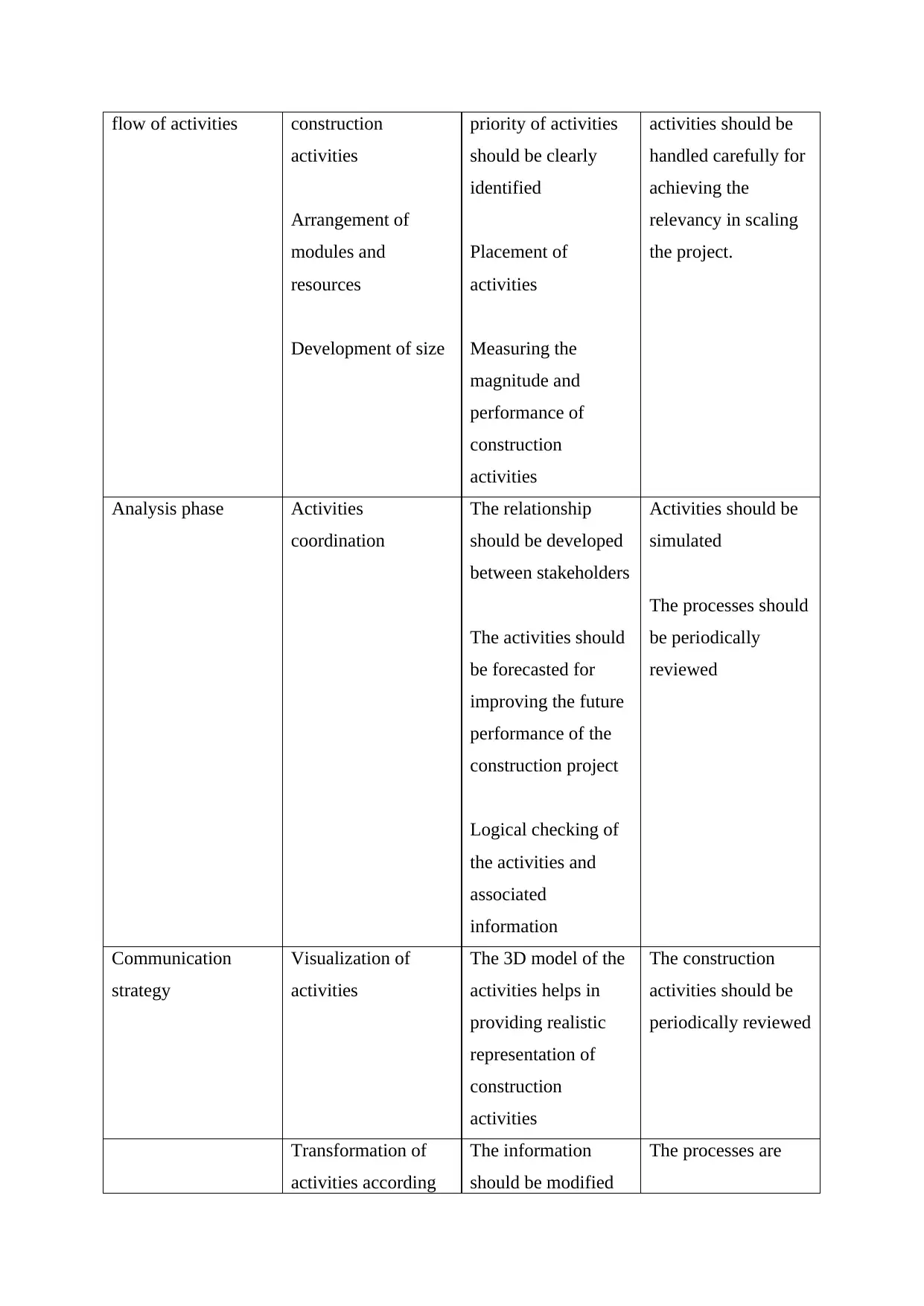
flow of activities construction
activities
Arrangement of
modules and
resources
Development of size
priority of activities
should be clearly
identified
Placement of
activities
Measuring the
magnitude and
performance of
construction
activities
activities should be
handled carefully for
achieving the
relevancy in scaling
the project.
Analysis phase Activities
coordination
The relationship
should be developed
between stakeholders
The activities should
be forecasted for
improving the future
performance of the
construction project
Logical checking of
the activities and
associated
information
Activities should be
simulated
The processes should
be periodically
reviewed
Communication
strategy
Visualization of
activities
The 3D model of the
activities helps in
providing realistic
representation of
construction
activities
The construction
activities should be
periodically reviewed
Transformation of
activities according
The information
should be modified
The processes are
activities
Arrangement of
modules and
resources
Development of size
priority of activities
should be clearly
identified
Placement of
activities
Measuring the
magnitude and
performance of
construction
activities
activities should be
handled carefully for
achieving the
relevancy in scaling
the project.
Analysis phase Activities
coordination
The relationship
should be developed
between stakeholders
The activities should
be forecasted for
improving the future
performance of the
construction project
Logical checking of
the activities and
associated
information
Activities should be
simulated
The processes should
be periodically
reviewed
Communication
strategy
Visualization of
activities
The 3D model of the
activities helps in
providing realistic
representation of
construction
activities
The construction
activities should be
periodically reviewed
Transformation of
activities according
The information
should be modified
The processes are
⊘ This is a preview!⊘
Do you want full access?
Subscribe today to unlock all pages.

Trusted by 1+ million students worldwide
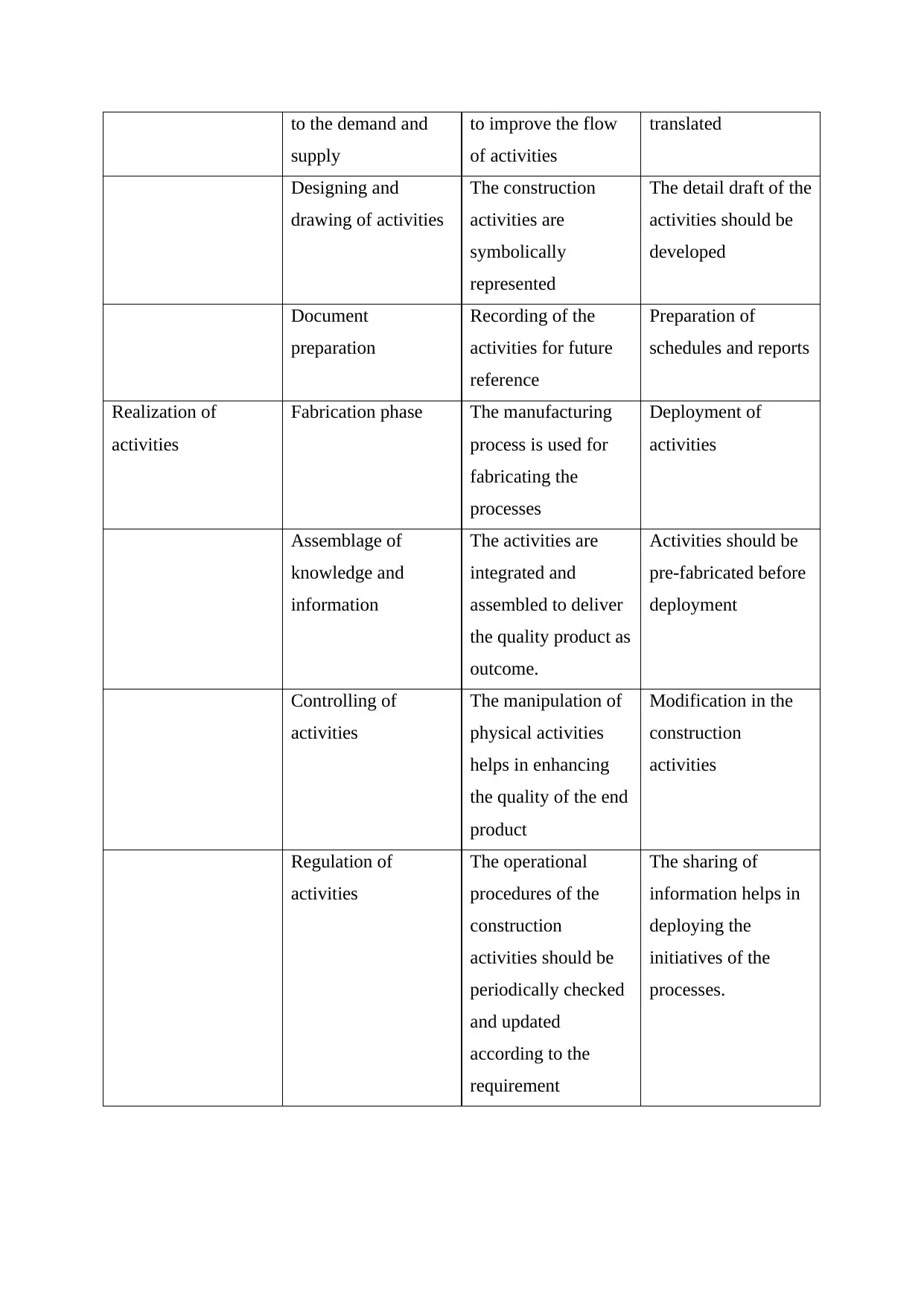
to the demand and
supply
to improve the flow
of activities
translated
Designing and
drawing of activities
The construction
activities are
symbolically
represented
The detail draft of the
activities should be
developed
Document
preparation
Recording of the
activities for future
reference
Preparation of
schedules and reports
Realization of
activities
Fabrication phase The manufacturing
process is used for
fabricating the
processes
Deployment of
activities
Assemblage of
knowledge and
information
The activities are
integrated and
assembled to deliver
the quality product as
outcome.
Activities should be
pre-fabricated before
deployment
Controlling of
activities
The manipulation of
physical activities
helps in enhancing
the quality of the end
product
Modification in the
construction
activities
Regulation of
activities
The operational
procedures of the
construction
activities should be
periodically checked
and updated
according to the
requirement
The sharing of
information helps in
deploying the
initiatives of the
processes.
supply
to improve the flow
of activities
translated
Designing and
drawing of activities
The construction
activities are
symbolically
represented
The detail draft of the
activities should be
developed
Document
preparation
Recording of the
activities for future
reference
Preparation of
schedules and reports
Realization of
activities
Fabrication phase The manufacturing
process is used for
fabricating the
processes
Deployment of
activities
Assemblage of
knowledge and
information
The activities are
integrated and
assembled to deliver
the quality product as
outcome.
Activities should be
pre-fabricated before
deployment
Controlling of
activities
The manipulation of
physical activities
helps in enhancing
the quality of the end
product
Modification in the
construction
activities
Regulation of
activities
The operational
procedures of the
construction
activities should be
periodically checked
and updated
according to the
requirement
The sharing of
information helps in
deploying the
initiatives of the
processes.
Paraphrase This Document
Need a fresh take? Get an instant paraphrase of this document with our AI Paraphraser
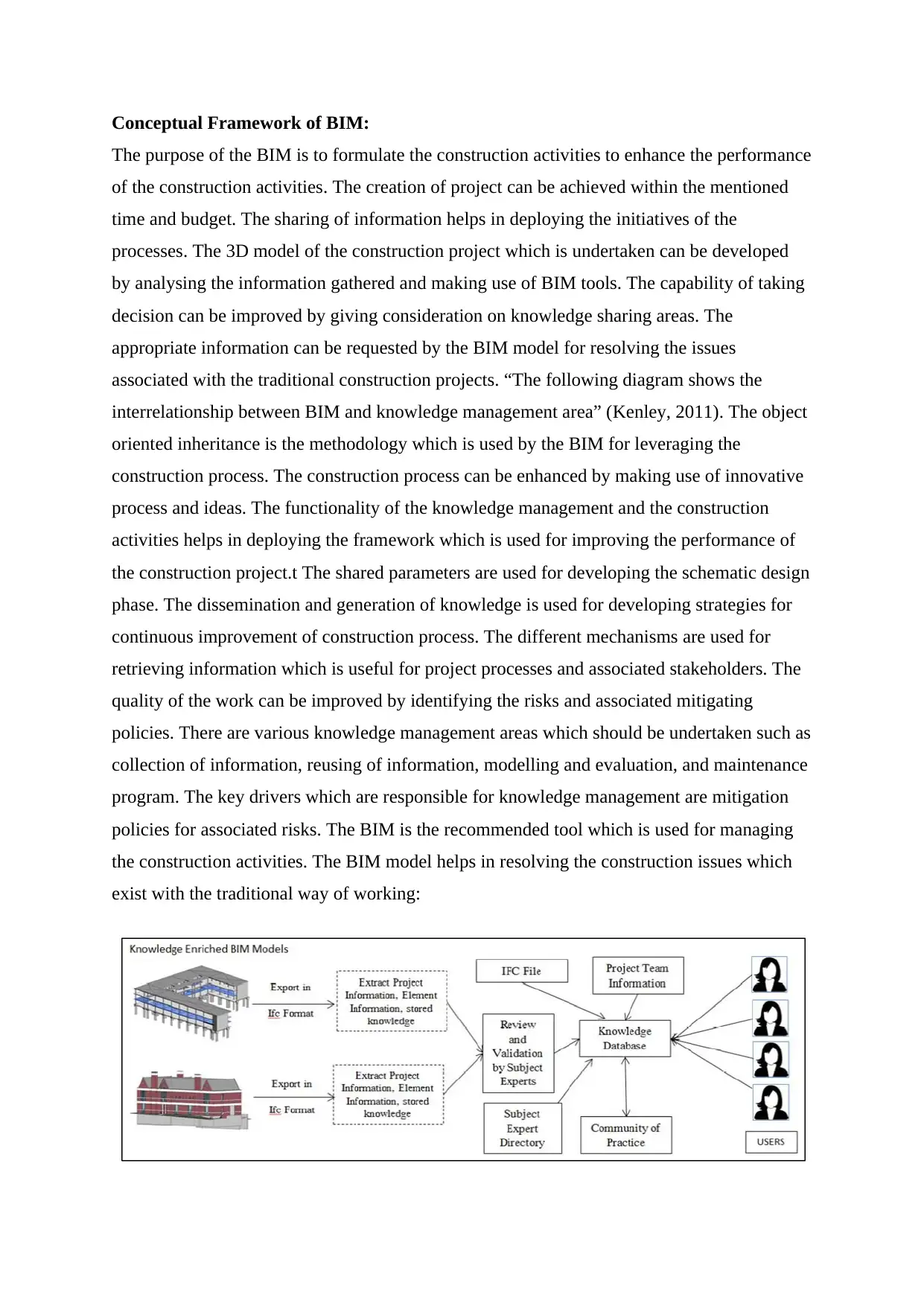
Conceptual Framework of BIM:
The purpose of the BIM is to formulate the construction activities to enhance the performance
of the construction activities. The creation of project can be achieved within the mentioned
time and budget. The sharing of information helps in deploying the initiatives of the
processes. The 3D model of the construction project which is undertaken can be developed
by analysing the information gathered and making use of BIM tools. The capability of taking
decision can be improved by giving consideration on knowledge sharing areas. The
appropriate information can be requested by the BIM model for resolving the issues
associated with the traditional construction projects. “The following diagram shows the
interrelationship between BIM and knowledge management area” (Kenley, 2011). The object
oriented inheritance is the methodology which is used by the BIM for leveraging the
construction process. The construction process can be enhanced by making use of innovative
process and ideas. The functionality of the knowledge management and the construction
activities helps in deploying the framework which is used for improving the performance of
the construction project.t The shared parameters are used for developing the schematic design
phase. The dissemination and generation of knowledge is used for developing strategies for
continuous improvement of construction process. The different mechanisms are used for
retrieving information which is useful for project processes and associated stakeholders. The
quality of the work can be improved by identifying the risks and associated mitigating
policies. There are various knowledge management areas which should be undertaken such as
collection of information, reusing of information, modelling and evaluation, and maintenance
program. The key drivers which are responsible for knowledge management are mitigation
policies for associated risks. The BIM is the recommended tool which is used for managing
the construction activities. The BIM model helps in resolving the construction issues which
exist with the traditional way of working:
The purpose of the BIM is to formulate the construction activities to enhance the performance
of the construction activities. The creation of project can be achieved within the mentioned
time and budget. The sharing of information helps in deploying the initiatives of the
processes. The 3D model of the construction project which is undertaken can be developed
by analysing the information gathered and making use of BIM tools. The capability of taking
decision can be improved by giving consideration on knowledge sharing areas. The
appropriate information can be requested by the BIM model for resolving the issues
associated with the traditional construction projects. “The following diagram shows the
interrelationship between BIM and knowledge management area” (Kenley, 2011). The object
oriented inheritance is the methodology which is used by the BIM for leveraging the
construction process. The construction process can be enhanced by making use of innovative
process and ideas. The functionality of the knowledge management and the construction
activities helps in deploying the framework which is used for improving the performance of
the construction project.t The shared parameters are used for developing the schematic design
phase. The dissemination and generation of knowledge is used for developing strategies for
continuous improvement of construction process. The different mechanisms are used for
retrieving information which is useful for project processes and associated stakeholders. The
quality of the work can be improved by identifying the risks and associated mitigating
policies. There are various knowledge management areas which should be undertaken such as
collection of information, reusing of information, modelling and evaluation, and maintenance
program. The key drivers which are responsible for knowledge management are mitigation
policies for associated risks. The BIM is the recommended tool which is used for managing
the construction activities. The BIM model helps in resolving the construction issues which
exist with the traditional way of working:
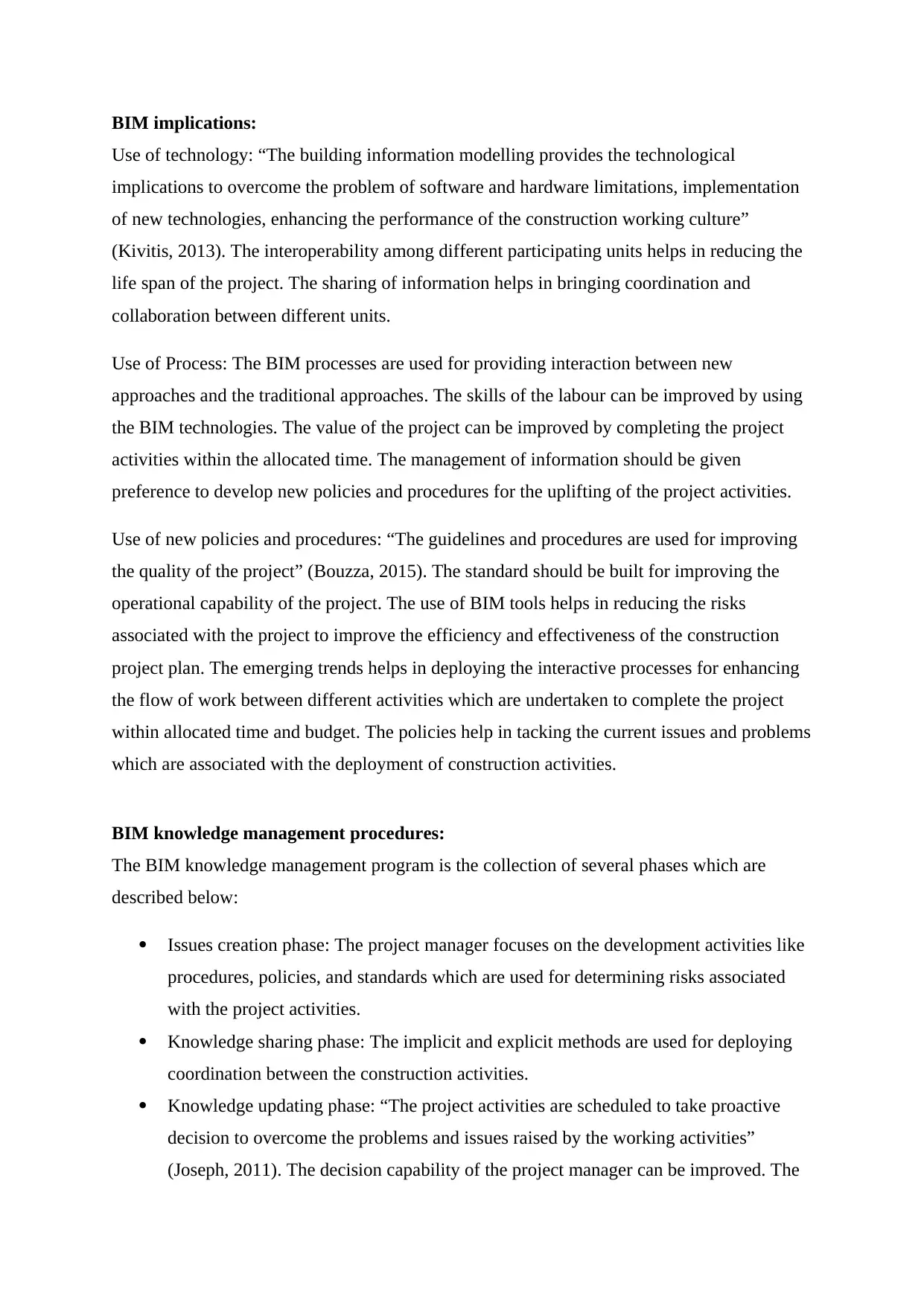
BIM implications:
Use of technology: “The building information modelling provides the technological
implications to overcome the problem of software and hardware limitations, implementation
of new technologies, enhancing the performance of the construction working culture”
(Kivitis, 2013). The interoperability among different participating units helps in reducing the
life span of the project. The sharing of information helps in bringing coordination and
collaboration between different units.
Use of Process: The BIM processes are used for providing interaction between new
approaches and the traditional approaches. The skills of the labour can be improved by using
the BIM technologies. The value of the project can be improved by completing the project
activities within the allocated time. The management of information should be given
preference to develop new policies and procedures for the uplifting of the project activities.
Use of new policies and procedures: “The guidelines and procedures are used for improving
the quality of the project” (Bouzza, 2015). The standard should be built for improving the
operational capability of the project. The use of BIM tools helps in reducing the risks
associated with the project to improve the efficiency and effectiveness of the construction
project plan. The emerging trends helps in deploying the interactive processes for enhancing
the flow of work between different activities which are undertaken to complete the project
within allocated time and budget. The policies help in tacking the current issues and problems
which are associated with the deployment of construction activities.
BIM knowledge management procedures:
The BIM knowledge management program is the collection of several phases which are
described below:
Issues creation phase: The project manager focuses on the development activities like
procedures, policies, and standards which are used for determining risks associated
with the project activities.
Knowledge sharing phase: The implicit and explicit methods are used for deploying
coordination between the construction activities.
Knowledge updating phase: “The project activities are scheduled to take proactive
decision to overcome the problems and issues raised by the working activities”
(Joseph, 2011). The decision capability of the project manager can be improved. The
Use of technology: “The building information modelling provides the technological
implications to overcome the problem of software and hardware limitations, implementation
of new technologies, enhancing the performance of the construction working culture”
(Kivitis, 2013). The interoperability among different participating units helps in reducing the
life span of the project. The sharing of information helps in bringing coordination and
collaboration between different units.
Use of Process: The BIM processes are used for providing interaction between new
approaches and the traditional approaches. The skills of the labour can be improved by using
the BIM technologies. The value of the project can be improved by completing the project
activities within the allocated time. The management of information should be given
preference to develop new policies and procedures for the uplifting of the project activities.
Use of new policies and procedures: “The guidelines and procedures are used for improving
the quality of the project” (Bouzza, 2015). The standard should be built for improving the
operational capability of the project. The use of BIM tools helps in reducing the risks
associated with the project to improve the efficiency and effectiveness of the construction
project plan. The emerging trends helps in deploying the interactive processes for enhancing
the flow of work between different activities which are undertaken to complete the project
within allocated time and budget. The policies help in tacking the current issues and problems
which are associated with the deployment of construction activities.
BIM knowledge management procedures:
The BIM knowledge management program is the collection of several phases which are
described below:
Issues creation phase: The project manager focuses on the development activities like
procedures, policies, and standards which are used for determining risks associated
with the project activities.
Knowledge sharing phase: The implicit and explicit methods are used for deploying
coordination between the construction activities.
Knowledge updating phase: “The project activities are scheduled to take proactive
decision to overcome the problems and issues raised by the working activities”
(Joseph, 2011). The decision capability of the project manager can be improved. The
⊘ This is a preview!⊘
Do you want full access?
Subscribe today to unlock all pages.

Trusted by 1+ million students worldwide
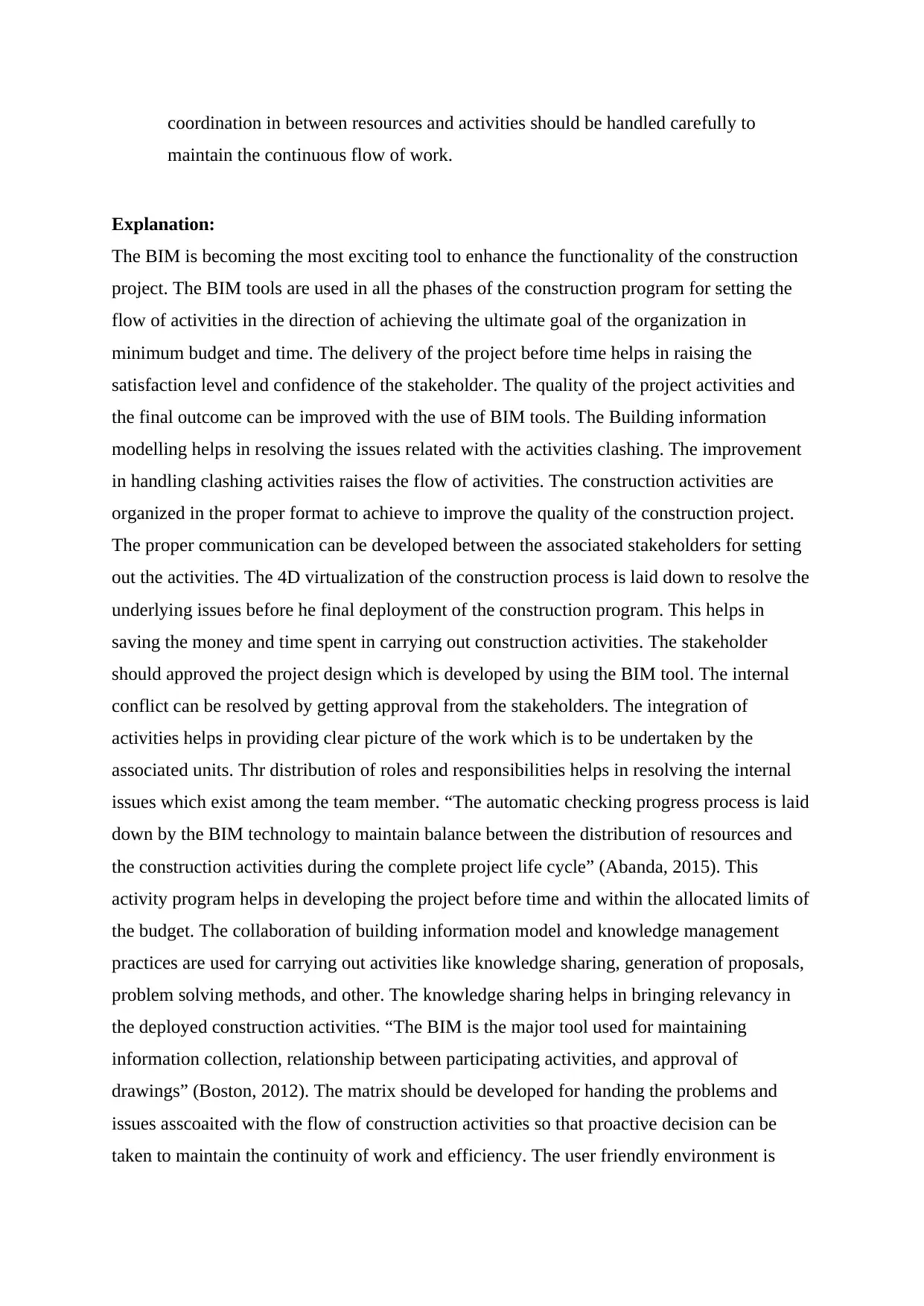
coordination in between resources and activities should be handled carefully to
maintain the continuous flow of work.
Explanation:
The BIM is becoming the most exciting tool to enhance the functionality of the construction
project. The BIM tools are used in all the phases of the construction program for setting the
flow of activities in the direction of achieving the ultimate goal of the organization in
minimum budget and time. The delivery of the project before time helps in raising the
satisfaction level and confidence of the stakeholder. The quality of the project activities and
the final outcome can be improved with the use of BIM tools. The Building information
modelling helps in resolving the issues related with the activities clashing. The improvement
in handling clashing activities raises the flow of activities. The construction activities are
organized in the proper format to achieve to improve the quality of the construction project.
The proper communication can be developed between the associated stakeholders for setting
out the activities. The 4D virtualization of the construction process is laid down to resolve the
underlying issues before he final deployment of the construction program. This helps in
saving the money and time spent in carrying out construction activities. The stakeholder
should approved the project design which is developed by using the BIM tool. The internal
conflict can be resolved by getting approval from the stakeholders. The integration of
activities helps in providing clear picture of the work which is to be undertaken by the
associated units. Thr distribution of roles and responsibilities helps in resolving the internal
issues which exist among the team member. “The automatic checking progress process is laid
down by the BIM technology to maintain balance between the distribution of resources and
the construction activities during the complete project life cycle” (Abanda, 2015). This
activity program helps in developing the project before time and within the allocated limits of
the budget. The collaboration of building information model and knowledge management
practices are used for carrying out activities like knowledge sharing, generation of proposals,
problem solving methods, and other. The knowledge sharing helps in bringing relevancy in
the deployed construction activities. “The BIM is the major tool used for maintaining
information collection, relationship between participating activities, and approval of
drawings” (Boston, 2012). The matrix should be developed for handing the problems and
issues asscoaited with the flow of construction activities so that proactive decision can be
taken to maintain the continuity of work and efficiency. The user friendly environment is
maintain the continuous flow of work.
Explanation:
The BIM is becoming the most exciting tool to enhance the functionality of the construction
project. The BIM tools are used in all the phases of the construction program for setting the
flow of activities in the direction of achieving the ultimate goal of the organization in
minimum budget and time. The delivery of the project before time helps in raising the
satisfaction level and confidence of the stakeholder. The quality of the project activities and
the final outcome can be improved with the use of BIM tools. The Building information
modelling helps in resolving the issues related with the activities clashing. The improvement
in handling clashing activities raises the flow of activities. The construction activities are
organized in the proper format to achieve to improve the quality of the construction project.
The proper communication can be developed between the associated stakeholders for setting
out the activities. The 4D virtualization of the construction process is laid down to resolve the
underlying issues before he final deployment of the construction program. This helps in
saving the money and time spent in carrying out construction activities. The stakeholder
should approved the project design which is developed by using the BIM tool. The internal
conflict can be resolved by getting approval from the stakeholders. The integration of
activities helps in providing clear picture of the work which is to be undertaken by the
associated units. Thr distribution of roles and responsibilities helps in resolving the internal
issues which exist among the team member. “The automatic checking progress process is laid
down by the BIM technology to maintain balance between the distribution of resources and
the construction activities during the complete project life cycle” (Abanda, 2015). This
activity program helps in developing the project before time and within the allocated limits of
the budget. The collaboration of building information model and knowledge management
practices are used for carrying out activities like knowledge sharing, generation of proposals,
problem solving methods, and other. The knowledge sharing helps in bringing relevancy in
the deployed construction activities. “The BIM is the major tool used for maintaining
information collection, relationship between participating activities, and approval of
drawings” (Boston, 2012). The matrix should be developed for handing the problems and
issues asscoaited with the flow of construction activities so that proactive decision can be
taken to maintain the continuity of work and efficiency. The user friendly environment is
Paraphrase This Document
Need a fresh take? Get an instant paraphrase of this document with our AI Paraphraser
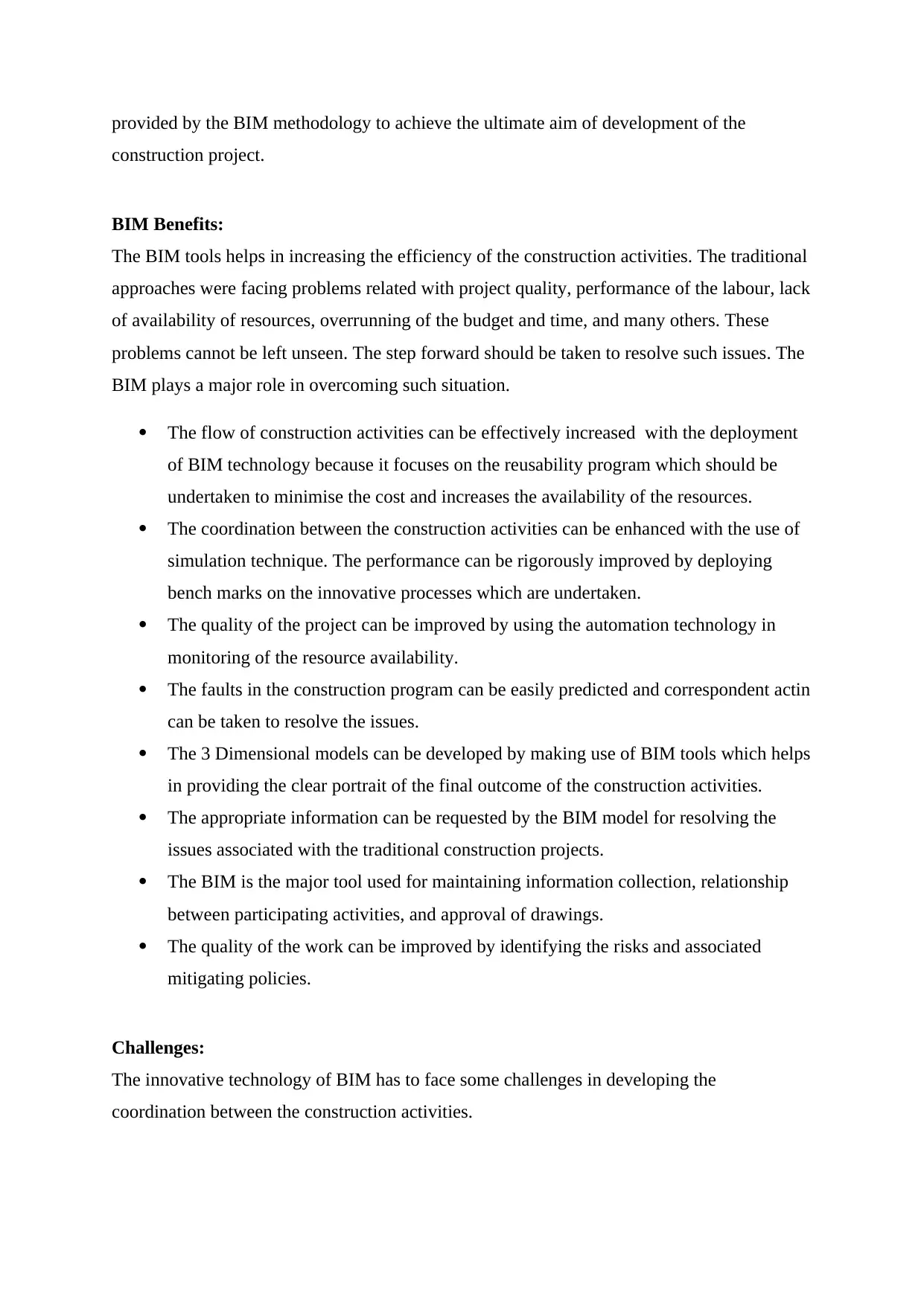
provided by the BIM methodology to achieve the ultimate aim of development of the
construction project.
BIM Benefits:
The BIM tools helps in increasing the efficiency of the construction activities. The traditional
approaches were facing problems related with project quality, performance of the labour, lack
of availability of resources, overrunning of the budget and time, and many others. These
problems cannot be left unseen. The step forward should be taken to resolve such issues. The
BIM plays a major role in overcoming such situation.
The flow of construction activities can be effectively increased with the deployment
of BIM technology because it focuses on the reusability program which should be
undertaken to minimise the cost and increases the availability of the resources.
The coordination between the construction activities can be enhanced with the use of
simulation technique. The performance can be rigorously improved by deploying
bench marks on the innovative processes which are undertaken.
The quality of the project can be improved by using the automation technology in
monitoring of the resource availability.
The faults in the construction program can be easily predicted and correspondent actin
can be taken to resolve the issues.
The 3 Dimensional models can be developed by making use of BIM tools which helps
in providing the clear portrait of the final outcome of the construction activities.
The appropriate information can be requested by the BIM model for resolving the
issues associated with the traditional construction projects.
The BIM is the major tool used for maintaining information collection, relationship
between participating activities, and approval of drawings.
The quality of the work can be improved by identifying the risks and associated
mitigating policies.
Challenges:
The innovative technology of BIM has to face some challenges in developing the
coordination between the construction activities.
construction project.
BIM Benefits:
The BIM tools helps in increasing the efficiency of the construction activities. The traditional
approaches were facing problems related with project quality, performance of the labour, lack
of availability of resources, overrunning of the budget and time, and many others. These
problems cannot be left unseen. The step forward should be taken to resolve such issues. The
BIM plays a major role in overcoming such situation.
The flow of construction activities can be effectively increased with the deployment
of BIM technology because it focuses on the reusability program which should be
undertaken to minimise the cost and increases the availability of the resources.
The coordination between the construction activities can be enhanced with the use of
simulation technique. The performance can be rigorously improved by deploying
bench marks on the innovative processes which are undertaken.
The quality of the project can be improved by using the automation technology in
monitoring of the resource availability.
The faults in the construction program can be easily predicted and correspondent actin
can be taken to resolve the issues.
The 3 Dimensional models can be developed by making use of BIM tools which helps
in providing the clear portrait of the final outcome of the construction activities.
The appropriate information can be requested by the BIM model for resolving the
issues associated with the traditional construction projects.
The BIM is the major tool used for maintaining information collection, relationship
between participating activities, and approval of drawings.
The quality of the work can be improved by identifying the risks and associated
mitigating policies.
Challenges:
The innovative technology of BIM has to face some challenges in developing the
coordination between the construction activities.
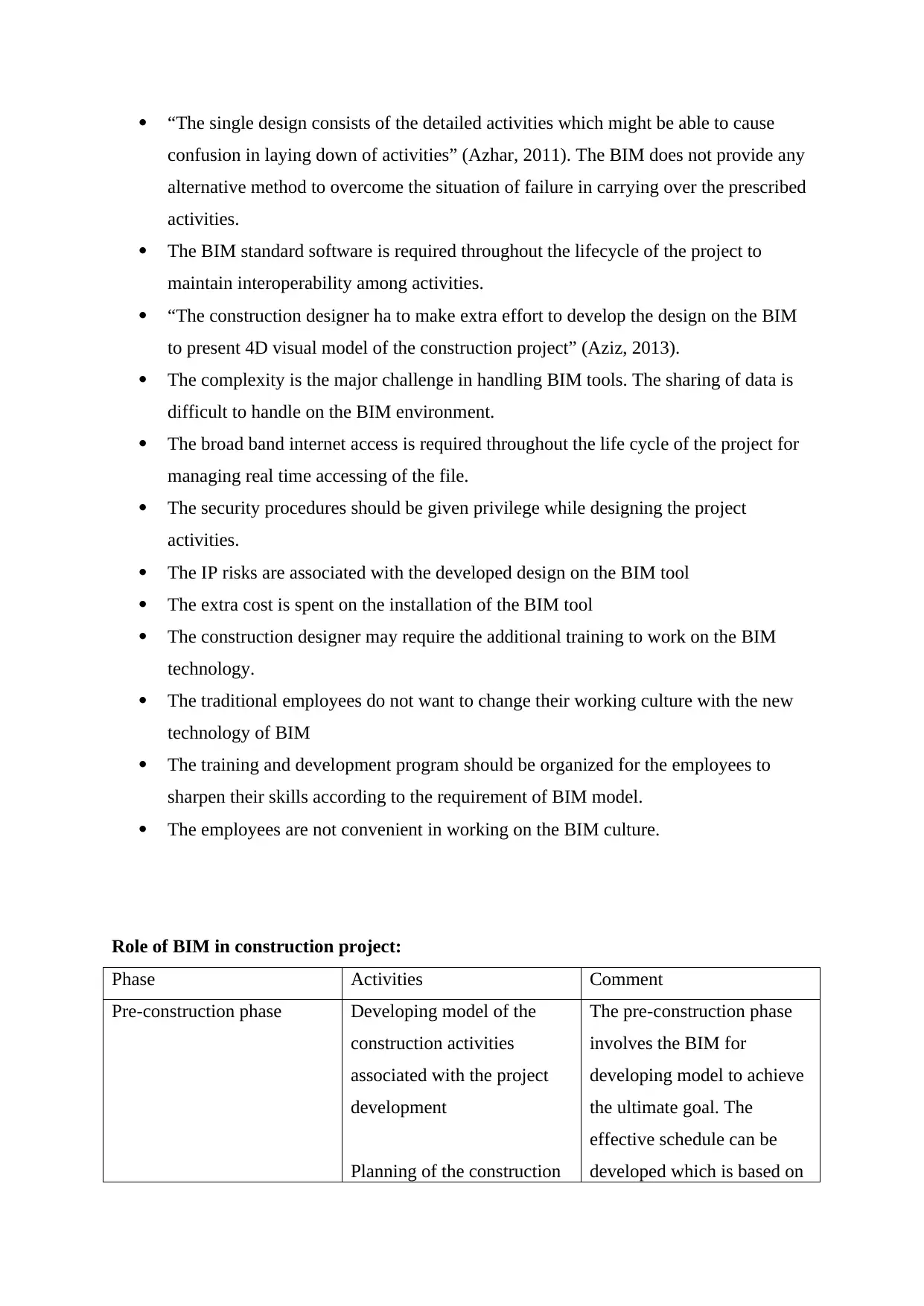
“The single design consists of the detailed activities which might be able to cause
confusion in laying down of activities” (Azhar, 2011). The BIM does not provide any
alternative method to overcome the situation of failure in carrying over the prescribed
activities.
The BIM standard software is required throughout the lifecycle of the project to
maintain interoperability among activities.
“The construction designer ha to make extra effort to develop the design on the BIM
to present 4D visual model of the construction project” (Aziz, 2013).
The complexity is the major challenge in handling BIM tools. The sharing of data is
difficult to handle on the BIM environment.
The broad band internet access is required throughout the life cycle of the project for
managing real time accessing of the file.
The security procedures should be given privilege while designing the project
activities.
The IP risks are associated with the developed design on the BIM tool
The extra cost is spent on the installation of the BIM tool
The construction designer may require the additional training to work on the BIM
technology.
The traditional employees do not want to change their working culture with the new
technology of BIM
The training and development program should be organized for the employees to
sharpen their skills according to the requirement of BIM model.
The employees are not convenient in working on the BIM culture.
Role of BIM in construction project:
Phase Activities Comment
Pre-construction phase Developing model of the
construction activities
associated with the project
development
Planning of the construction
The pre-construction phase
involves the BIM for
developing model to achieve
the ultimate goal. The
effective schedule can be
developed which is based on
confusion in laying down of activities” (Azhar, 2011). The BIM does not provide any
alternative method to overcome the situation of failure in carrying over the prescribed
activities.
The BIM standard software is required throughout the lifecycle of the project to
maintain interoperability among activities.
“The construction designer ha to make extra effort to develop the design on the BIM
to present 4D visual model of the construction project” (Aziz, 2013).
The complexity is the major challenge in handling BIM tools. The sharing of data is
difficult to handle on the BIM environment.
The broad band internet access is required throughout the life cycle of the project for
managing real time accessing of the file.
The security procedures should be given privilege while designing the project
activities.
The IP risks are associated with the developed design on the BIM tool
The extra cost is spent on the installation of the BIM tool
The construction designer may require the additional training to work on the BIM
technology.
The traditional employees do not want to change their working culture with the new
technology of BIM
The training and development program should be organized for the employees to
sharpen their skills according to the requirement of BIM model.
The employees are not convenient in working on the BIM culture.
Role of BIM in construction project:
Phase Activities Comment
Pre-construction phase Developing model of the
construction activities
associated with the project
development
Planning of the construction
The pre-construction phase
involves the BIM for
developing model to achieve
the ultimate goal. The
effective schedule can be
developed which is based on
⊘ This is a preview!⊘
Do you want full access?
Subscribe today to unlock all pages.

Trusted by 1+ million students worldwide
1 out of 17
Related Documents
Your All-in-One AI-Powered Toolkit for Academic Success.
+13062052269
info@desklib.com
Available 24*7 on WhatsApp / Email
![[object Object]](/_next/static/media/star-bottom.7253800d.svg)
Unlock your academic potential
Copyright © 2020–2025 A2Z Services. All Rights Reserved. Developed and managed by ZUCOL.




